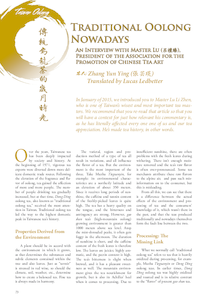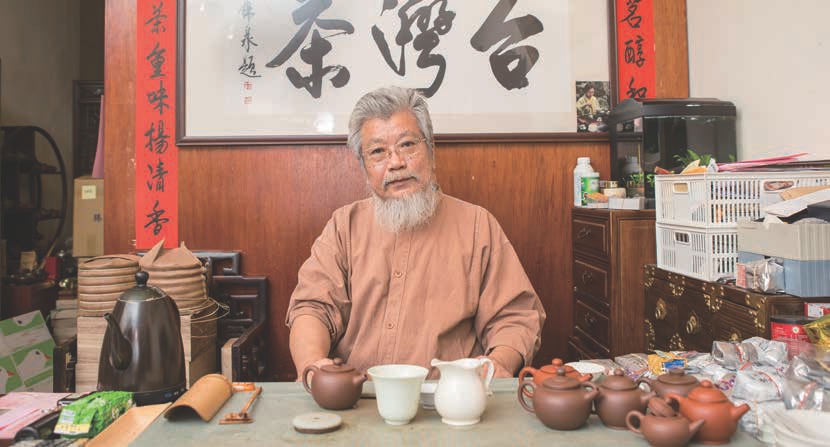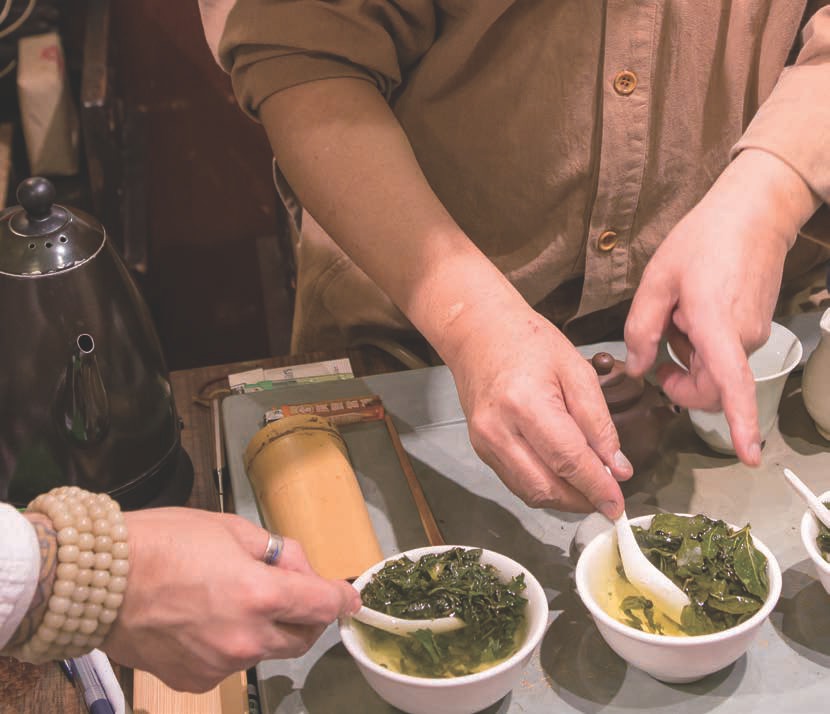
 |
|

Over the years, Taiwanese tea has been deeply impacted by society and history. At the beginning of 1971, vigorous tea exports were diverted down more delicate domestic trade routes. Following the elevation of the fragrance and flavor of oolong, tea gained the affection of more and more people. The number of people drinking tea gradually increased, but at that time, Dong Ding oolong tea, also known as "traditional oolong tea," received the most attention in Taiwan. Traditional oolong tea led the way to the highest domestic peak in Taiwanese tea's history.
A plant should be in accord with the environment in which it grows, as that determines the substances and subtle elements contained within the tree and also leaves. Just as "terroir" is stressed in red wine, so should the climate, soil, weather, etc., determine how to create a balanced tea. Fine tea is always made in harmony.
The varietal, region and production method of a type of tea all result in variations, and all influence the flavor of a tea. But the environment is the most important of the three. Take Muzha Tieguanyin, for example: its environmental characteristics are a northerly latitude and an elevation of about 350 meters. Since it receives long periods of sunshine, the caffeine and tannin content of the freshly-picked leaves is quite high. The tea has a heavy quality on the tongue, and the bitterness and astringency are strong. However, gao shan tea's (high-mountain oolong) growing environment is greater than 1000 meters above sea level. Atop the mist-shrouded peaks, it often gets foggy in the afternoon. The duration of sunshine is short, and the caffeine content of the fresh leaves is therefore low. The leaves are juicier, highly aromatic, and the pectin content is high. The tea's bitterness is slight when brewed, and it has a pleasant sweetness as well. The mountain environment gives the tea nourishment for growth, but is also its Achilles' heel when it comes to processing. Due to insufficient sunshine, there are often problems with the fresh leaves during withering. There isn't enough moisture removed and the tea's raw flavor is often over-pronounced. Some tea merchants attribute these raw flavors to the alpine air, and pass such misinformation on to the consumer, but this is misleading.
From all this, we can see that there is a difference between the actual effects of the environment and processing of tea and the consumers' knowledge of it, which wasn't there in the past, and that the teas produced traditionally and nowadays themselves form the fault line between the two.
What we normally call "traditional oolong tea" refers to tea that is heavily oxidized during processing, for example, Muzha Tieguanyin or Dong Ding oolong teas. In earlier times, Dong Ding oolong tea was highly oxidized and roasted and is in relative contrast to the "flavor" of present gao shan tea.
In 1971, the traditional oolong tea produced by tea farms underwent withering in the sunshine for oxidation. A preliminary roasting, shaking, and other processes made the tea highly oxidized; during rolling, it was pressed in cloth by hand or foot. The tea took on a ball shape and was called "balled oolong." In withering this tea, masters would wait until the raw tea flavor had left the tea leaves, and then perform the next step. The process was adjusted in accordance with Nature, echoing changes in rainfall, temperature, humidity, etc.
These complicated but reliable production skills lowered the moisture in the tea leaves to an appropriate degree. Not only was the aroma stabilized in the process, but the mouthfeel, flavor and heartiness (body) were also greatly increased. Moreover, such teas were suitable to be drunk right away or stored for later.
Let's look at another example: Due to the growing conditions and characteristics of traditional Muzha Tieguanyin, it is intrinsically rather bitter. Thus, tea farms used a relatively high degree of oxidation, the tea was rolled quite a few times and the roasting period was fairly long. In the end, that tempered the varietal and environment's "aggressive" flavor, transforming its shortcoming into its specialty.
High-mountain oolong tea currently undergoes light oxidation, and most of the stages of processing are done by machine. What's more, some people believe that small farmers using traditional production techniques should be phased out and that large-scale mechanical tea production methods should be adopted instead, for example, factory-farm cooperation (small farmers don't have to set up factories; they just provide maocha and the processing is done by large factories). This method not only can save on wages, but can mass-produce tea, which is advantageous to the development of the tea industry, market, and economy. However, when tea leaves are machine-processed, they do not acquire natural flavors. Manufactured tea is only mediocre and lacks any special characteristics. It cannot be adapted to the varietal, climate or environment and lacks craftsmanship and character.
I think the key to high-quality tea lies in letting the nature of tea "reveal itself." This doesn't just refer to the degree of oxidation we've been discussing, but to every phase of the production process. Traditionally, oolong masters tried to avoid creating tea with raw flavors. If you let oolong reveal its potential, it won't have a green tea or fresh-off-the-tree flavor, and as such, it will be more conducive to tea craftsmanship - in the processing, roast and even brewing skills.
Asides from letting the tea "reveal itself," there is another key point, which is the tea's dryness. The moisture content must be less than 5%. When the tea liquor has a freshly-picked, raw green flavor, that indicates that the tea leaves have a high moisture content, and the tea will be bitter when drunk (the surface of the tongue will have a slight astringent feeling), and it will not be suitable for aging. Processing an oolong the way it wants to be processed, revealing its true potential, and making sure it is adequately dry will make a fine oolong that is pleasant to drink and worth aging for some years as well.
The main reason that nowadays tea mostly undergoes light oxidation and is not thoroughly dried is that at present, the "aroma" of the tea is emphasized. There are crude teas and raw teas that have a very apparent aroma when smelled. One could describe this type of fragrance as "charming."
Then how to stabilize the aroma? Tea that hasn't been sufficiently oxidized can be roasted directly after drying. The tea's fragrance will change with the high roasting temperature and will be preserved layer by layer. This changes the "evenness" in the original aroma into "heartiness." In other words, it reduces the shortcomings of the tea, decreases the acerbity, and increases its supple smoothness. Tea that has not been roasted can be likened to a gorgeous woman who is uncultured, left alone on an island: she is beautiful, but not as beautiful as she could be. Similarly, fine tea from a fine source and location is great, but it won't reach its full potential as oolong without the roast.
Thus, when a tea farmer roasts a tea over a long period, the aroma is transformed from an obvious, charming flavor into a mellow and complex poem, deeper and more profound. Take Li Shan spring tea as an example (like our Tea of the Month): it has a clear floral fragrance as raw tea, but after roasting, it is transformed and reveals a mellow floral and fruity fragrance, which smells gentle and pleasant. The tea then seems to cling to the mouth, adhering everywhere and lingering on. This takes the experience to an even higher level.
I think the true quality one experiences when drinking tea is more holistic than just a pleasant aroma. In the past, we often talked about a tea's ability to "rhyme (cha yun, 茶韻)." In the old days, tea was produced "in concordance with the Heavens," and it was good for aging as well as drinking.
I have some Taiwanese oolong tea here from the year 1916. The depths of the tea liquor have a burgundy translucence. After the tea enters the mouth, the sweetness instantly floods your whole mouth. There is a slight, pleasant bitterness in the sweetness. Different levels and flavors dance upon the tongue in tingling sensations, melting the body and mind. Only vintage tea can offer such an experience. It is like the qualities of the tea are fulfilled by the aging. And that is an experience which light, raw tea with only a pleasant fragrance can't ever compete with.
To date, along with changes in technology and the environment, people's demand for tea has also changed. The market has been influenced by these changes. For example, because modern people drink tea with increasingly light flavors, lightly oxidized teas have gradually gained popularity, as have the newer cultivars, like Jing shuan or Four Seasons Spring.
In addition, tea information is basically controlled by tea merchants. When consumers don't have access to objective information that can help them develop discernment, it's very easy to feel that a certain tea suits you, and to then grow a preference for it - after a while, you become accustomed to this type of flavor. (Magazines like this can obviously help!)
There are also many challenges in the sales of Taiwanese teas, such as that Taiwanese teas have a low profit margin. Sometimes, without any mark-up, even after twenty years, a tea is still sold at a comparable or even lower price as it was back then. These issues are not guided by a reasonable system, resulting in a chaotic market and tea farmers who can't earn a livelihood.
Taiwanese tea's specialty lies in its high quality. If quantity is demanded, how do we preserve and maintain that quality? Traditional craftsmanship pushed Taiwanese tea toward a peak and offered people memorable flavors. The modern market, on the other hand, has a very different attitude towards tea.
This topic can't be covered in so few words. Based on my years of experience, many people like Taiwanese tea after coming into contact with it. I believe that with the right attitude, Taiwanese tea can achieve another peak, maybe even higher than the previous one.

Taiwanese tea's specialty lies in its high quality. If quantity is demanded, how do we preserve and maintain that quality? Traditional craftsmanship pushed Taiwanese tea toward a peak and offered people memorable flavors. The modern market, on the other hand, has a very different attitude towards tea.
